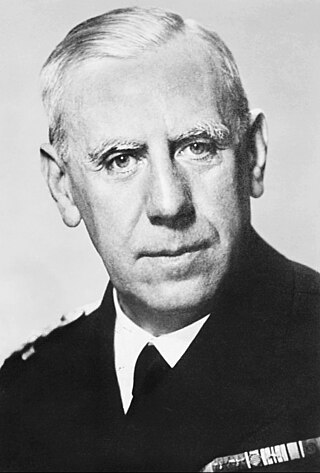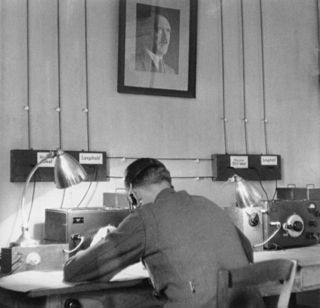
Ultra was the designation adopted by British military intelligence in June 1941 for wartime signals intelligence obtained by breaking high-level encrypted enemy radio and teleprinter communications at the Government Code and Cypher School (GC&CS) at Bletchley Park. Ultra eventually became the standard designation among the western Allies for all such intelligence. The name arose because the intelligence obtained was considered more important than that designated by the highest British security classification then used and so was regarded as being Ultra Secret. Several other cryptonyms had been used for such intelligence.

Wilhelm Franz Canaris was a German admiral and the chief of the Abwehr from 1935 to 1944. Canaris was initially a supporter of Adolf Hitler, and the Nazi regime. Following the German invasion of Poland in 1939, however, Canaris turned against Hitler and committed acts of both passive and active resistance during the war.

Operation Felix was the codename for a proposed German invasion of Spain and seizure of Gibraltar during the Second World War. Subject to the co-operation of the Spanish dictator, Francisco Franco, the operation did not occur chiefly because of Franco's reluctance to enter the war due to influence of British intelligence.
Operation Goldeneye was an Allied stay-behind plan during the Second World War to monitor Spain after a possible alliance between Francisco Franco and the Axis powers, and to undertake sabotage operations. The plan was formed by Commander Ian Fleming of the Naval Intelligence Division (NID). No German takeover of Spain took place, nor an invasion of Gibraltar, and the plan was shelved in 1943. Fleming later used the name for his Jamaican home where he wrote the James Bond stories.

Operation Berlin was a raid conducted by the two German Scharnhorst-class battleships against Allied shipping in the North Atlantic between 22 January and 22 March 1941. It formed part of the Battle of the Atlantic during World War II. The Scharnhorst and Gneisenau sailed from Germany, operated across the North Atlantic, sank or captured 22 Allied merchant vessels, and finished their mission by docking in occupied France. The British military sought to locate and attack the German battleships, but failed to damage them.

Operation Stoneage or Operation Stone Age was an Allied convoy operation to the Mediterranean island of Malta in the Second World War. To disguise the destination of the ships, some took on their cargo at Port Sudan in the Red Sea. The four ships of Convoy MW 13 sailed from Alexandria on 16 November, escorted by cruisers, destroyers and round-the-clock air cover from captured airfields in Egypt and Cyrenaica.

During World War II, the Spanish State under Francisco Franco espoused neutrality as its official wartime policy. This neutrality wavered at times, and "strict neutrality" gave way to "non-belligerence" after the Fall of France in June 1940. Franco wrote to Adolf Hitler offering to join the war on 19 June 1940 in exchange for help building Spain's colonial empire. Later in the same year Franco met with Hitler in Hendaye to discuss Spain's possible accession to the Axis Powers. The meeting went nowhere, but Franco did help the Axis—whose members Italy and Germany had supported him during the Spanish Civil War (1936–1939)—in various ways.
Operation Cascade was the codename for an Allied military deception operation during the Western Desert Campaign of World War II for North Africa. Operation Cascade was one of the first successful Allied deception operations in World War II, and provided valuable experience for later operations.

The military history of Gibraltar during World War II exemplifies Gibraltar's position as a British fortress since the early 18th century and as a vital factor in British military strategy, both as a foothold on the continent of Europe, and as a bastion of British sea power. During World War II, Gibraltar served a vital role in both the Atlantic Theatre and the Mediterranean Theatre, controlling virtually all naval traffic into and out of the Mediterranean Sea from the Atlantic Ocean.

The Abwehr was the German military-intelligence service for the Reichswehr and the Wehrmacht from 1920 to 1945. Although the 1919 Treaty of Versailles prohibited the Weimar Republic from establishing an intelligence organization of their own, they formed an espionage group in 1920 within the Ministry of Defence, calling it the Abwehr. The initial purpose of the Abwehr was defence against foreign espionage: an organizational role which later evolved considerably. Under General Kurt von Schleicher the individual military services' intelligence units were combined and, in 1929, centralized under Schleicher's Ministeramt within the Ministry of Defence, forming the foundation for the more commonly understood manifestation of the Abwehr.

The auxiliary ship Olterra was a 5,000 ton Italian tanker scuttled by her own crew at Algeciras in the Bay of Gibraltar on 10 June 1940, after the entry of Italy in World War II. She was recovered in 1942 by a special unit of the Decima Flottiglia MAS to be used as an undercover base for manned torpedoes in order to attack Allied shipping at Gibraltar.
The Italian Military Information Service was the military intelligence organization for the Royal Army of the Kingdom of Italy from 1925 until 1946, and of the Italian Republic until 1949. The SIM was Fascist dictator Benito Mussolini's equivalent to the German Abwehr. In the early years of the war, the SIM scored important intelligence successes. Rommel’s successful military operations in North Africa in 1942 were substantially facilitated by the SIM through the securing of the U.S. Black Code used by Colonel Bonner Fellers to communicate plans for British military operations to his Headquarters in Washington.

The Algeciras campaign was an attempt by a French naval squadron from Toulon under Contre-Admiral Charles Linois to join a French and Spanish fleet at Cadiz during June and July 1801 during the French Revolutionary Wars prior to a planned operation against either Egypt or Portugal. To reach Cadiz, the French squadron had to pass the British naval base at Gibraltar, which housed the squadron tasked with blockading Cadiz. The British squadron was commanded by Rear-Admiral Sir James Saumarez. After a successful voyage between Toulon and Gibraltar, in which a number of British vessels were captured, the squadron anchored at Algeciras, a fortified port city within sight of Gibraltar across Gibraltar Bay. On 6 July 1801, Saumarez attacked the anchored squadron, in the First Battle of Algeciras. Although severe damage was inflicted on all three French ships of the line, none could be successfully captured and the British were forced to withdraw without HMS Hannibal, which had grounded and was subsequently seized by the French.

Operation Calendar in 1942 was an Anglo–American operation in the Second World War to deliver Supermarine Spitfire fighter aircraft to Malta. The aircraft were desperately needed to bolster the island's defence against strong Axis air raids.

Operation Bowery was an Anglo-American operation during the Second World War to deliver fighter aircraft to Malta, an operation known informally as a Club Run. Spitfires were needed to replace the remaining obsolete Hurricane fighters, to defend Malta from Axis air raids.

Operation Portcullis was the voyage of the Allied Convoy MW 14 with supplies to Malta from Port Said in Eygpt during the Second World War. The convoy followed the success of Operation Stoneage which had raised the Siege of Malta. Four merchant ships were escorted to Malta by seven destroyers of the 12th Destroyer Flotilla, supported by three cruisers of the 15th Cruiser Squadron and three destroyers from Alexandria.

Operation Bolívar was the codename for the German espionage in Latin America during World War II. It was under the operational control of Section D (4) from the Foreign Security Service (Ausland-SD), and was primarily concerned with the collection and transmission of clandestine information from Latin America to Europe. Overall, the Germans were successful in establishing a secret radio communications network from their control station in Argentina, as well as a courier system involving the use of Spanish merchant vessels for the shipment of paper-form intelligence.
Ángel Alcázar de Velasco was an apprentice bullfighter, Falangist, journalist and spy.














